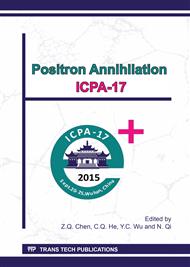[1]
H. -E. Schaefer, R. Würschum, R. Birringer,H. Gleiter, Phys. Rev. B 38 (1988) 9545-9554.
DOI: 10.1103/physrevb.38.9545
Google Scholar
[2]
Jakub Čížek, Ivan Procházka, Miroslav Cieslar, Radomír Kužel, Jan Kuriplach, František Chmelík, Ivana Stulíková, František Bečvář, Oksana Melikhova, Rinat K. Islamgaliev, Phys. Rev. B 65 (2002) 094106.
DOI: 10.1103/physrevb.65.094106
Google Scholar
[3]
S. Van Petegem, F. Dalla Torre, D. Segers,H. Van Swygenhoven, Scripta Mater. 48 (2003) 17–22.
DOI: 10.1016/s1359-6462(02)00322-6
Google Scholar
[4]
Kai Zhou, Hui Li, JinBiao Pang, Zhu Wang, Philos. Mag. 92 (2012) 2079-(2088).
Google Scholar
[5]
Kai Zhou, Ting Zhang, Zhu Wang, Phys. Scr. 90 (2015) 105701.
Google Scholar
[6]
Hideaki Ohkubo, Z. Tang, Y. Nagai, M. Hasegawa, T. Tawara,M. Kiritani, Mater. Sci. Eng. A 350 (2003) 95-101.
Google Scholar
[7]
Jakob Schiøtz, Karsten W. Jacobsen, Science 301 (2003) 1357-1359.
Google Scholar
[8]
Kai Zhou, Bin Liu, Yijun Yao, Kun Zhong, Mater. Sci. Eng. A 615 (2014) 92–97.
Google Scholar
[9]
S. Traiviratana, E. M. Bringa, D. J. Benson,M. A. Meyers, Acta Mater. 56 (2008) 3874-3886.
DOI: 10.1016/j.actamat.2008.03.047
Google Scholar
[10]
S. Plimpton, J. Comp. Phys. 117 (1995) 1-19.
Google Scholar
[11]
X.W. Zhou, R.A. Johnson H.N.G. Wadley, Phys. Rev. B 69 (2004) 144113.
Google Scholar
[12]
W. Trifthauser J.D. McGervey, Appl. Phys. 6 (1975) 177-180.
Google Scholar
[13]
T. Torsti, T. Eirola, J. Enkovaara, T. Hakala, P. Havu, V. Havu, T. Hoynalanmaa, J. Ignatius, M. Lyly, I. Makkonen, T.T. Rantala, J. Ruokolainen, K. Ruotsalainen, E. Rasanen, H. Saarikoski M.J. Puska, Phys. Stat. Sol. B 243 (2006) 1016-1053.
DOI: 10.1002/pssb.200541348
Google Scholar
[14]
M. J. Puska,R. M. Nieminen, Rev. Mod. Phys. 66 (1994) 841-897.
Google Scholar
[15]
M. J. Puska,R. M. Nieminen, J. Phys. F: Met. Phys. 13 (1983) 333-346.
Google Scholar
[16]
E. Boroński,R. M. Nieminen, Phys. Rev. B 34 (1986) 3820-3831.
Google Scholar
[17]
K. Momma,F. Izumi, J. Appl. Crystallogr. 44 (2011) 1272-1276.
Google Scholar
[18]
K. Zhou, B. Liu, Y.J. Yao,K. Zhong, Mat. Sci. Eng. A 595 (2014) 118-125.
Google Scholar
[19]
J. Kuriplach, Appl. Surf. Sci. 194 (2002) 61-70.
Google Scholar


